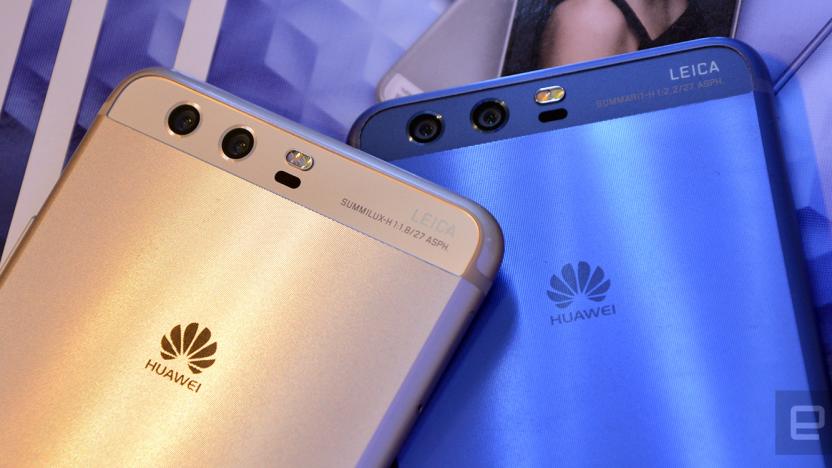eMMC
Latest

NHTSA wants Tesla to recall 158,000 Tegra 3-equipped vehicles
NHTSA is pushing Tesla for a full recall to deal with a memory chip that can wear out and cause touchscreens in Model S and Model X EVs to go blank.

Huawei blames slower P10s on memory shortage
Memory speed isn't always something that one would pay attention to when buying a smartphone, or at least you'd expect the latest flagships to come with the fastest options available at the time, but it turns out that this isn't necessarily true. Recently, some Huawei P10 and P10 Plus users in China noticed that they were only getting eMMC 5.1 memory speeds on their devices. For instance, the sequential read speeds were in the ballpark of 250MB/s on AndroBench, whereas the luckier folks who got UFS 2.0 or 2.1 chips on their phones managed to hit around 550MB/s or even 750MB/s (our very own international unit got 786.67MB/s). Indeed, Huawei never specified the type of flash memory on its P10 spec sheets, which led to speculations that the mobile giant was intentionally misleading consumers.

Samsung can put 128GB of storage in your low-cost phone
Just because you're not splurging on a top-of-the-line smartphone doesn't mean that you have to settle for a tiny amount of storage. Samsung certainly thinks that way -- it just announced a 3-bits-per-cell flash memory chip that promises 128GB of storage in "mass market" (read: more affordable) mobile devices. It's based on the plain eMMC tech you see in most phones instead of the fast UFS format inside the Galaxy S6, but you probably won't complain about the speed when it can still read sequential data at a very respectable 260MB per second. The one catch? There's no word on when it'll be ready, so you may be waiting a while before you're carrying a budget phone with more drive space than some laptops. [Top image credit: Samsung Tomorrow, Flickr]

Samsung develops 'world's fastest' embedded memory, first with eMMC 5.0
The evolution of mobile memory chips keeps moving faster, if Samsung's progress is any indication. Not eight months since churning out those speedy eMMC 4.5 chips, and the company's next version of NAND is already here. Indeed, the South Korean company says it's now in mass production of what it deems as the world's fastest embedded memory. The new eMMC PRO chip is based on 64GB 10nm class NAND flash technology and would be the first to support the eMMC 5.0 standard. The chips will be available in the usual 16, 32 and 64GB iterations and feature an interface speed of 400MB/s. The 32 and 64GB densities in particular boast random read and write speeds of 7,000 IOPS (inputs/outputs per second) and sequential read and write speeds of 250MB/s and 90MB/s respectively. What do all of those numbers mean? Well, they should translate to much better performance when it comes to multitasking, browsing, file transfers, HD video capture, gaming and just general computing. Combined with the firm's upcoming Exynos 5 Octa 5420 SoC, and we're champing at the bit to see them implemented in Samsung's next generation of mobile devices.

Tegra 4 reference tablets use SanDisk iNAND Extreme, mate a fast CPU with fast storage
It's well established that NVIDIA's Tegra 4 is at least reasonably quick. It's only quick when the storage isn't a bottleneck, however, which is why SanDisk has negotiated a repeat partnership as the official storage supplier for reference Tegra 4 tablets. Pop open one of the designs and you'll find either 16GB or 32GB of SanDisk's iNAND Extreme keeping pace with the quad-core processor. The reference deal may be more than just a publicity grab: it raises the chance that companies will use the speedier flash memory in their own Tegra 4 slates. Whether or not SanDisk makes it to shipping devices, the deal could lead to balanced tablet hardware that seldom leaves us waiting.

Samsung's new 10nm-process 64GB mobile flash memory chips are smaller, faster, better
Even though Samsung only announced volume production of ultra-fast eMMC memory chips back in August, it's already upgrading to a newer generation of hardware. Moving from the previous 20nm process to 10nm, the new 64GB eMMC Pro Class 2000 has a 20 percent smaller physical footprint, and claims 30 percent advantages in both performance and manufacturing productivity. While its previous chips only starting taking advantage of JEDEC's eMMC 4.5 interface standard a few months ago, Samsung plans to approach the group next year to create a new standard that can handle this design. It has a write speed of 2,000 IOPS (input/output per second) and a read speed of 5,000 IOPS, besting the 1,500/3,500 numbers reported on the older hardware, and kicks up the bandwidth to 260 MB/s read and 50MB/s write. These chips went into production late last month and are destined for slim phones and tablets near you, even if they don't say Samsung on the outside.

Samsung starts mass-producing 4x faster mobile flash memory, kickstarts our phones and tablets
Samsung isn't content to leave fast NAND flash memory to traditional solid-state drives. Its Pro Class 1500 promises a big jolt to the performance of frequently pokey smartphone and tablet storage. By how much? That name is a clue -- it reaches 1,500 IOPS (inputs/outputs per second) when writing data, which along with 3,500 IOPS data reads is about four times faster than any previous embedded flash chip Samsung has tested. In the real world, that leads to as much as 140MB/s when reading data and 50MB/s for writes. The speed comes after Samsung has thrown virtually every trick in the book at its new chips, including a dense 20-nanometer manufacturing process, quick toggle DDR 2.0 memory with its own controller and a new JEDEC memory standard with 200MB/s of bandwidth to spare. Samsung hasn't named customers for the 16GB, 32GB and 64GB parts that are rolling out of the factories, although we'd do well to remember that a flourishing phone business doesn't guarantee that the only major customer is Samsung itself: even in the face of legal challenges, Samsung still has at least one noteworthy client that tends to snap up much of its flash supply.

Toshiba cooks up 128GB NAND flash for next-gen phones and PMPs
Leave it to Toshiba to make even the latest smartphones feel somewhat undernourished. Quadrupling the current high-end standard of 32GB of embedded memory, the Japanese company has announced an all-new 128GB slab of storage, built on a 32nm production process. It's somehow managed to fit sixteen 8GB NAND chips, plus their controller, inside a 1.4mm tall structure, and samples are about to exit the factory doors this September. A 64GB variant will also be making an appearance, with both scheduled to enter mass production sometime during the fourth quarter. Should go pretty nicely with that 2GHz beastphone Moto is planning, don't you think?

Toshiba launches 32GB embedded NAND for PMPs and handsets
Look out memory nerds, as Toshiba has just announced a more capacious embedded NAND flash memory device than you ever thought possible. The new 32GB chip boasts full compliance with eMMC and eSD standards, is fabricated with Tosh's 43-nanometer process technology, includes a dedicated controller and should slip right into your favorite handset / PMP of tomorrow. Samples are slated to hit couriers in September for an undisclosed price, while mass production will get going in Q4. So, how long 'til you guys and gals repeat this news with "64" or "128" in place of that lowly "32?"[Via Electronista]




